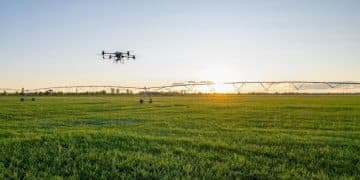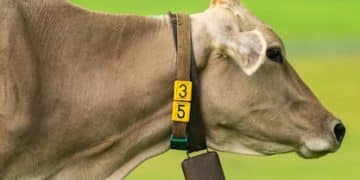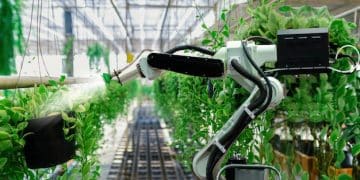5G Revolution: How It’s Transforming Smart Farming in the US
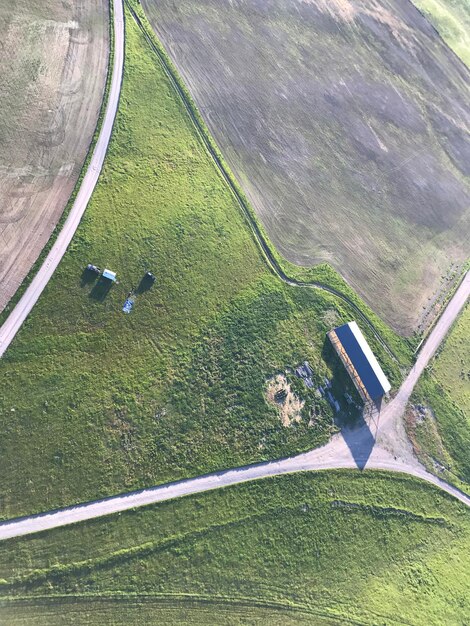
5G technology is revolutionizing smart farming in the US by enabling faster data transmission, more efficient decision-making, and ultimately, higher yields through real-time monitoring and automation of agricultural processes.
The agricultural sector in the United States is undergoing a significant transformation, and the impact of 5G on smart farming: faster data, better decisions, higher yields is at the forefront of this change. Imagine a world where every inch of farmland is monitored in real-time, where decisions are made based on instant data analysis, and where resources are used with unparalleled efficiency. This isn’t a futuristic fantasy; it’s the reality that 5G technology is rapidly bringing to American farms.
Unlocking the Potential of 5G in Agriculture
The agricultural sector stands to gain immensely from the integration of 5G technology. Its promise lies in enhanced connectivity, reduced latency, and increased bandwidth, providing farmers with unprecedented access to real-time data and automation capabilities. The journey, however, begins with understanding the breadth of improvements that 5G can bring to agriculture.
Enhanced Connectivity and Data Transmission
5G networks offer substantially faster data transmission rates and lower latency than their predecessors. For smart farming, this means:
* **Real-time Monitoring:** Farmers can receive immediate updates from sensors placed across their fields, enabling them to pinpoint issues such as crop stress or pest infestations as soon as they arise.
* **Remote Control:** Automated machinery, drones, and other smart devices can be controlled remotely with minimal delay, allowing for precise interventions.
* **Big Data Analytics:** Large datasets generated by various farm technologies can be processed rapidly, providing valuable insights for optimizing farming practices.
Precision Agriculture and Resource Management
5G supports the adoption of precision agriculture techniques, which involve tailoring practices to the specific needs of different sections of a farm. This results in optimized resource utilization and increased yields.
* **Variable Rate Application:** Farmers can use data from sensors and drones to determine the precise amount of water, fertilizer, and pesticides required in different areas of their fields, reducing waste and minimizing environmental impact.
* **Smart Irrigation:** 5G-enabled irrigation systems can automatically adjust water distribution based on real-time soil moisture data, optimizing water use and crop health.
* **Livestock Monitoring:** Sensors attached to livestock can track their health, activity levels, and location, enabling farmers to detect and address potential problems promptly.

The synergy between 5G and smart agriculture offers farmers unparalleled opportunities to optimize their operations. With improved connectivity, greater precision, and data-driven insights, they can make more informed decisions, resulting in higher yields, reduced costs, and sustainable practices.
Applications of 5G in Smart Farming
5G technology has found applications in several areas of smart farming, from crop management to livestock monitoring to even food supply chain efficiency.
* **Smart Irrigation Systems:** Wireless sensors monitor soil moisture and weather conditions. Data transmitted over 5G allows automated systems to adjust water distribution, optimizing usage.
* **Autonomous Tractors:** Self-driving tractors use real-time data to navigate fields safely. 5G enables rapid data processing and precise control.
* **Livestock Monitoring:** Real-time tracking of animal health, location, and behavior. Immediate identification of sick or distressed animals via data relayed over 5G to farmers.
* **Drone Crop Monitoring:** Drones equipped with cameras and sensors can scan fields. Farmers receive real-time data on crop health, pest issues, etc.
* **Predictive Analytics:** Analyze large datasets of weather, soil conditions, and more. Farmers can make informed decisions about planting, irrigation, harvesting.
Farming is moving towards real-time analysis of data, optimized resource use, and greater productivity with 5G technology.
Benefits of 5G for Farmers
5G offers significant benefits to farmers. Enhanced connectivity, automation, and analytical insights from 5G have the potential to reshape modern agriculture.
* **Increased Crop Yields:** Data-driven decisions and automated processes can optimize planting, watering, and harvesting.
* **Reduced Costs:** Optimized resource use, automated machinery, and predictive maintenance reduce operating expenses.
* **Improved Sustainability:** Precise application of fertilizers and pesticides minimizes environmental impact.
* **Enhanced Efficiency:** Farmers can manage larger areas and automate labor-intensive tasks, increasing overall productivity.
Through 5G, farms can be more efficient, productive, and sustainable, leading to overall success.
Challenges and Considerations
While the potential of 5G in smart farming is enormous, there are several challenges and considerations that need to be addressed for effective implementation.
Infrastructure Requirements
Implementing 5G technology in rural areas requires significant infrastructure investment, including:
* **Base Stations:** Installing and maintaining 5G base stations across agricultural regions can be costly, especially in remote and sparsely populated areas.
* **Fiber Optic Backhaul:** High-capacity fiber optic networks are needed to support the data transmission requirements of 5G.
* **Power Supply:** Reliable power sources are essential to keep 5G infrastructure running, particularly in areas prone to power outages.
Data Security and Privacy
The increased connectivity associated with 5G raises concerns about data security and privacy:
* **Cybersecurity Threats:** Farms are vulnerable to cyberattacks that could disrupt operations, steal data, or tamper with automated systems.
* **Data Protection:** Protecting sensitive farm data from unauthorized access and misuse is crucial, particularly as more data is collected and shared.
* **Privacy Regulations:** Farmers need to comply with data privacy regulations, such as the General Data Protection Regulation (GDPR), when collecting and processing personal data.
Skills and Training
To fully leverage the potential of 5G, farmers need to acquire new skills and knowledge:
* **Technology Proficiency:** Farmers need to understand how to use and maintain 5G-enabled technologies, such as sensors, drones, and data analytics platforms.
* **Data Analysis Skills:** Farmers need to be able to interpret data and make informed decisions based on the insights they gain.
* **Cybersecurity Awareness:** Farmers need to be aware of cybersecurity threats and how to protect their systems and data.
Addressing these challenges and considerations is essential to ensure that 5G can be effectively implemented in smart farming and contribute to sustainable and efficient agriculture.
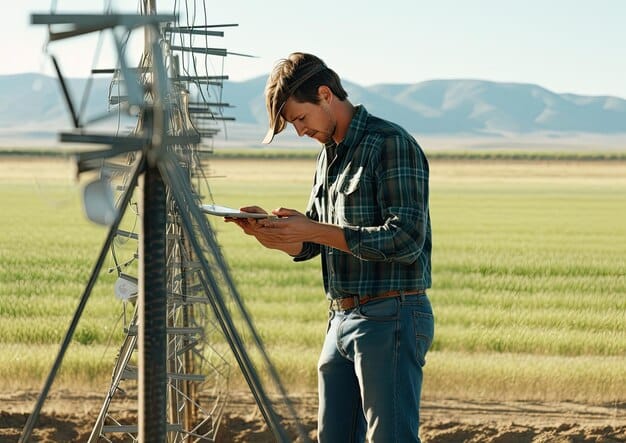
The Future of 5G in Smart Farming
The future of farming is bright with 5G. Expect to see ongoing technological development, broader adoption, and increasing integration between systems in the coming years.
Advances in Technology
Expect these technological advances:
* **AI Enhancement:** AI algorithms will further refine data analysis and predictive models, enabling even more precise decision-making.
* **Edge Computing:** Edge computing will bring data processing closer to the source, reducing latency and enabling real-time control of automated systems.
* **IoT Integration:** 5G will facilitate the seamless integration of various IoT devices, creating a comprehensive network of interconnected agricultural technologies.
Broader Adoption
These developments will increase adoption:
* **Cost Reduction:** As 5G technology matures, costs will decrease, making it more accessible to small and medium-sized farms.
* **Government Support:** Governments will play a crucial role in promoting the adoption of 5G through incentives, subsidies, and infrastructure investments.
* **Education and Training:** Increased education and training programs will equip farmers with the skills and knowledge needed to leverage 5G effectively.
US Case Studies: 5G Success Stories in Agriculture
* **California Vineyards:** Wireless sensors monitor moisture, temperature, and sunlight. Data is transmitted over 5G for precision water management for higher yields and quality.
* **Iowa Cornfields:** Autonomous drones scan crops, using 5G-powered analysis to identify areas in need of attention. Reduced pesticide use and optimized harvests result.
* **Texas Cattle Ranches:** Livestock fitted with 5G-enabled sensors provide real-time health and location data. Reduced losses from disease and theft, along with improved overall cattle management.
Farmers across the US are becoming more efficient, productive, and sustainable through 5G technology.
| Key Point | Brief Description |
|---|---|
| 🌱 Enhanced Connectivity | Faster data transmission rates and lower latency enable real-time monitoring. |
| 🚜 Precision Farming | Tailoring practices to specific field needs optimizes resource use. |
| 🐄 Livestock Monitoring | Sensors track health, activity, and location for prompt problem detection. |
| 💰 Cost Reduction | Optimized resource use, automated machinery, and predictive maintenance cut expenses. |
Frequently Asked Questions
▼
5G significantly enhances data transmission providing faster rates and lower latency, which allows for real-time monitoring of crops, livestock, and equipment.
▼
Precision agriculture involves tailoring farming practices to the specific needs of different areas. This includes optimizing water, fertiliser, and pesticide application for increased efficiency.
▼
Farmers can use sensors to track livestock health via 5G networks. They receive real-time data on the animals’ well-being, which supports prompt detection of health issues.
▼
Challenges include needing high infrastructure investment, data security threats, and a demand for skilled training for farmers to properly use and manage the tech.
▼
5G enables optimized resource use with fertilizer and pesticide applications. This minimizes environmental impact while increasing crop returns and overall sustainability of agriculture.
Conclusion
The integration of 5G technology presents a transformative opportunity for smart farming in the US. While challenges remain, the potential for increased efficiency, reduced costs, and improved sustainability makes embracing 5G a vital step towards the future of agriculture.

